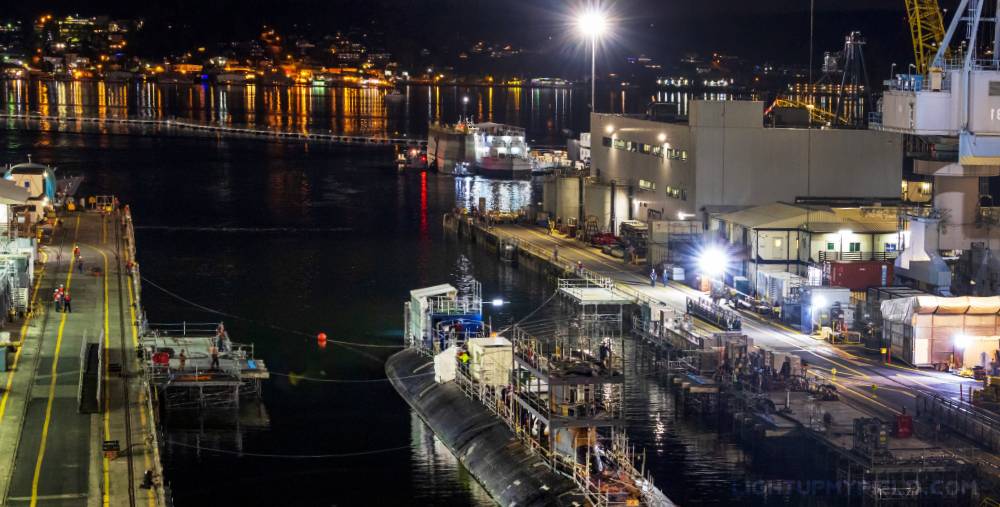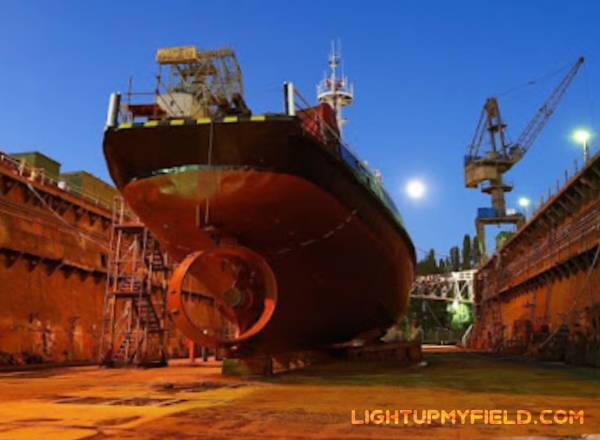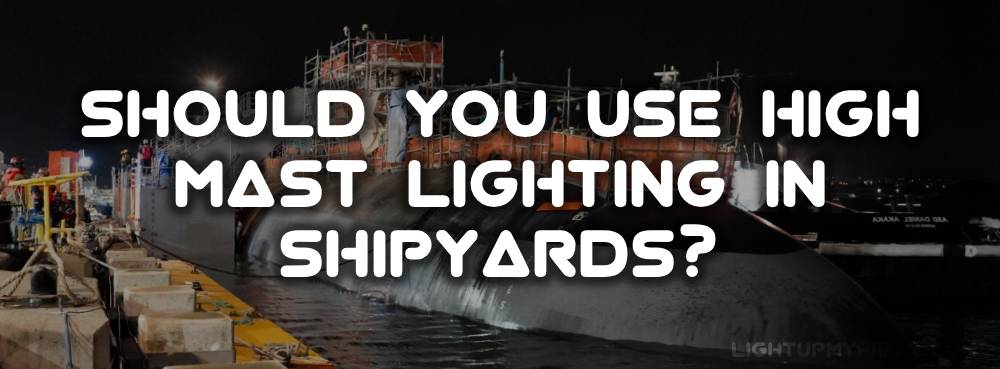When it comes to lighting up a shipyard, the choices you make can seriously impact safety, productivity, and even costs. One option that pops up a lot is high mast lighting. But is it the right move for your operation? Let’s dig into what high mast lighting actually is, weigh the pros and cons of using it in shipyards, and explore how to pick the right poles and fixtures if you decide to go that route.
Table of Contents
ToggleWhat Is High Mast Lighting?
High mast lighting refers to tall poles, typically anywhere from 20 to 50 meters (65 to 165 feet) high, that hold multiple powerful floodlights at the top. These lights are designed to illuminate large outdoor areas uniformly, like stadiums, airports, highways—and yes, shipyards.
The main idea is to get a broad, even spread of light from a high vantage point so you don’t have those annoying dark spots and harsh shadows that can make work tougher and less safe. Since shipyards cover massive spaces filled with bulky machinery, cranes, and vessels, lighting from above gives a good overview and helps workers see what’s happening all around.
One cool feature about many high mast systems is they can be lowered for maintenance, which means changing bulbs or cleaning fixtures is safer and easier. That’s a big deal when you’re talking about poles that might be 30 meters tall or more.

Should We Use High Mast Lights?
The quick answer? High mast lighting can seriously change the game for shipyards, but whether it’s right for you really boils down to your unique situation.
Size Matters – Why Your Shipyard’s Scale Counts
First off, think about how big your shipyard is. These high mast lights are designed to cover large, open spaces with a wide, consistent spread of light. When you’ve got a massive area to cover, like several thousand square meters or more, high mast poles save you from cramming the yard full of shorter light poles that can get in the way of machinery and workers.
For example, a typical high mast pole might be anywhere from 20 to 40 meters tall, and can light up an area roughly 100 to 150 meters in diameter. So, if your yard stretches out across several football fields, a handful of these poles can light things up pretty evenly. On the flip side, if your yard is more compact, or packed with tight corners and narrow pathways, high mast lighting might actually be less efficient. Their wide beams can’t really zoom in on small or tricky areas, which means you might end up with dim spots or light spilling where you don’t want it.
Night and Bad Weather Visibility – More Than Just Bright Lights
One of the best things about high mast lighting is how it helps keep the yard bright and safe, especially when the sun goes down or the weather gets rough. Working in a shipyard often means dealing with slippery decks, huge cranes moving around, and big vessels blocking sight lines. Good lighting reduces the chances of accidents by helping everyone see what’s going on.
According to industrial safety studies, better lighting setups can cut workplace accidents by up to 30%. That’s a huge deal, especially when you consider the cost of downtime, injuries, or worse. Beyond safety, proper lighting can actually boost productivity, because workers don’t have to squint or slow down trying to see what they’re doing.
The Cost and Installation – What You’re Getting Into
 Now, these lights don’t come cheap. The initial investment for high mast lighting includes the poles, the powerful floodlights, and the installation itself. These poles often require deep concrete foundations—sometimes a meter or more deep—and cranes or specialized rigs to put them in place. It’s not just about sticking a pole in the ground; it’s a whole project.
Now, these lights don’t come cheap. The initial investment for high mast lighting includes the poles, the powerful floodlights, and the installation itself. These poles often require deep concrete foundations—sometimes a meter or more deep—and cranes or specialized rigs to put them in place. It’s not just about sticking a pole in the ground; it’s a whole project.
Maintenance is another factor. Thankfully, many modern systems are built to lower the mast so crews can change bulbs or clean fixtures safely from the ground. That feature alone can save tons of headaches and reduce downtime. But still, routine upkeep on poles that are 30 meters tall or more is no small task.
Energy Use – The Wattage Behind Those Bright Lights
High mast lighting typically relies on LED floodlights ranging from 400 watts up to 1000 watts per fixture. Although LEDs are much more energy-efficient than traditional metal halide or sodium vapor lamps, running multiple fixtures like that through long night shifts adds up. For example, if you have 6 fixtures rated at 800 watts each, running 12 hours a day, that’s roughly 57.6 kWh per day, which translates to significant power consumption over a month.
However, modern shipyards are getting smarter about this. Many systems now come equipped with dimmers, motion sensors, or timers so the lights don’t have to blast at full power all night. When no one’s working in a particular section, the lights can automatically dial down, saving both energy and costs.
When High Mast Lighting Makes Sense – and When It Doesn’t
If your shipyard operates around the clock—think heavy welding, loading, unloading, inspections, and general maintenance—high mast lighting is usually a no-brainer. It gives you broad, bright coverage that keeps everything visible and running smoothly. For 24/7 operations, the safety and productivity gains often outweigh the higher upfront and energy costs.
On the other hand, if your yard is smaller, or your work mostly happens during daylight hours, you might want to consider other lighting options. More targeted lighting setups, like low-level floodlights or portable LED fixtures, can focus light where it’s needed without the big investment or energy use of high mast poles.
At the end of the day, matching your lighting to your specific needs and budget is what really matters. High mast lighting is a powerful tool in the right environment, but it’s not a one-size-fits-all solution. Think about the size of your yard, your work hours, the type of tasks you’re doing, and how much you’re willing to spend upfront and on energy before making the call.
Guide to Select the High Mast Light Pole
Choosing the right high mast light pole isn’t just about picking the tallest one or the cheapest option—it’s about finding the right balance between height, strength, and how well it can handle the conditions of your shipyard.
Getting the Height Right
Most shipyards lean toward poles that are between 20 and 35 meters tall. Why that range? Well, the taller the pole, the bigger the area each light can cover, meaning you need fewer poles overall. That’s a plus because fewer poles mean less clutter and less chance of getting in the way of cranes or heavy equipment.
But there’s a trade-off: as the pole gets taller, the light spreads out more and becomes less intense on the ground. Lighting pros often suggest spacing poles about 3 to 4 times the pole’s height apart. So, for a 30-meter pole, you’d space them roughly 90 to 120 meters apart to keep the light even without creating dark patches or annoying glare spots.
What’s the Pole Made Of?
Materials play a big role, especially since shipyards deal with salty, humid air and strong weather. Most high mast poles are either steel or aluminum. Steel poles are heavy but incredibly tough and can last decades with the right anti-corrosion treatment, which is a must near the ocean. They’re also better at holding up under heavy lighting fixtures and harsh weather conditions.
Aluminum poles, on the other hand, are lighter and easier to install, which can save time and money upfront. But they might not be as durable over the long haul, especially if your shipyard faces strong storms or heavy winds regularly.
Wind Loads and Weather Toughness
Speaking of weather, don’t overlook wind. Shipyards, especially those close to the coast, can get hit by gusts that push poles to their limits. The poles you choose need to be designed to handle the wind speeds typical for your location.
If you’re dealing with winds of around 120 km/h (75 mph) or higher, your poles must be engineered to resist bending, shaking, or worse. A pole that flexes too much or isn’t sturdy enough won’t just risk damage; it could affect the lighting stability and safety around the yard.
Maintenance Made Easier
One feature that makes life way easier is a pole with a built-in winch or hydraulic system. These let you lower the entire light cluster down to ground level for routine maintenance like changing bulbs or cleaning fixtures.
This kind of system cuts out the need for cranes, lifts, or dangerous climbing, saving both time and risk. Considering that some poles might be 30 meters or taller, having this option can make a huge difference in keeping your lighting system up and running smoothly without constant headaches.
Finding the Right Fit
In the end, picking the right high mast pole comes down to your shipyard’s size, weather conditions, and maintenance preferences. A well-chosen pole will help you get bright, even lighting that keeps the yard safe and productive, while making installation and upkeep as hassle-free as possible.
Guide to Select the High Mast Light
Picking the right light fixtures for your high mast poles is just as important as choosing the poles themselves. If you get this wrong, you might end up with dark spots, wasted energy, or even poor visibility that slows work down.
Finding the Right Beam Angle
One of the first things to consider is the beam angle of the floodlights. If the beam is too narrow, you’ll have to cram in lots of fixtures close together to avoid shadowy areas, which can quickly hike up your costs and energy bills. On the flip side, if the beam is too wide, the light spreads out too much, making the brightness weaker where it counts.
For shipyards, a beam angle between 60° and 90° usually hits the sweet spot. This range covers a wide enough area to light up big zones without sacrificing the intensity workers need to see clearly. So, you’re getting broad coverage and enough punch to avoid those annoying dark patches that can mess with productivity and safety.
How Much Wattage Do You Need?
Wattage ties into both the size of your shipyard and the brightness you’re after. For instance, a 600-watt LED floodlight typically outputs around 90,000 lumens. That kind of light can brightly cover an area roughly 60 meters across if mounted about 30 meters up. Of course, most yards will use several fixtures per pole—anywhere from 4 to 12 depending on how detailed the work is and how big the space is.
This means your lighting setup can be customized. Heavy-duty tasks like welding or inspections will need more powerful lights or more fixtures to maintain a higher brightness level, often around 150 to 200 lux. General yard lighting might get by with less, around 100 lux.
Quality Inside Matters
Don’t just look at wattage and beam angles; what’s inside the fixture counts a lot too. The type of LED chips and drivers will affect both how well the light performs and how long it lasts. Ideally, you want fixtures rated for at least 50,000 hours of use—that’s almost 6 years if running 24/7—and with a Color Rendering Index (CRI) over 70. The CRI score tells you how natural colors will appear under the light, which helps workers spot problems more easily. Low CRI can wash out colors, making it tougher to catch small issues.
Weatherproofing Is Non-Negotiable
Shipyards are rough places for electronics, especially near the sea where salt spray, dust, and moisture are constant threats. Your fixtures need to be tough enough to handle all that without failing. Look for at least an IP65 rating, meaning the lights are fully protected against dust and can withstand jets of water.
If your lights aren’t weatherproof, you’ll be replacing them often, which means more downtime and more money spent. In marine environments, corrosion from salt can destroy cheap fixtures fast, so it’s worth investing in well-built, corrosion-resistant lights.
Smart Features for Energy Savings
More and more fixtures now come with smart controls built right in, like dimming options, motion sensors, or remote monitoring. These features can bump up the initial cost but often pay off by saving energy and making maintenance easier.
For example, motion sensors can dim lights when areas are unoccupied or brighten only when activity is detected. Remote monitoring lets you track if a fixture is failing or running inefficiently, so you can fix problems before they cause bigger headaches. Over time, these smart features can cut energy use by 20-30% or more, which adds up fast on a large scale.
Matching Fixtures to Your Shipyard
At the end of the day, the best high mast lights for your shipyard will depend on how big your yard is, what kind of work gets done there, and how much you want to invest upfront versus save on energy and maintenance later. But starting with good quality, appropriately powered LED fixtures with the right beam angle and solid weatherproofing will set you up for a lighting system that lasts and keeps the yard safe and productive for years to come.
Looking Ahead
High mast lighting isn’t just a big pole with bright bulbs. It’s a strategic choice that can elevate shipyard operations—literally and figuratively. It helps keep workers safe, makes night shifts less stressful, and boosts overall efficiency.
That said, it’s not a one-size-fits-all. Knowing the size of your yard, how you work, and your budget will point you toward the right solution. And if you decide to go with high mast lights, careful planning on pole height, spacing, fixture choice, and maintenance access will make all the difference between good lighting and great lighting.
Bright spaces make for smooth operations, and sometimes the best way to light up a shipyard is from way above.

